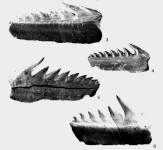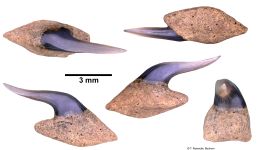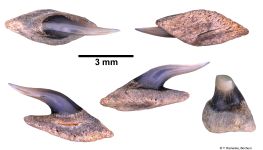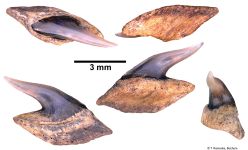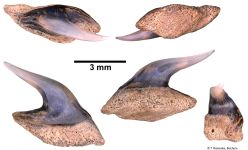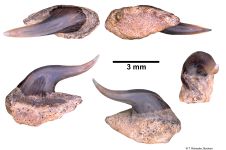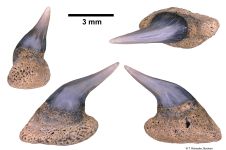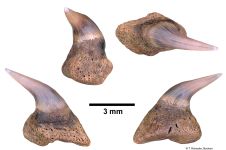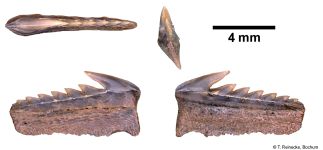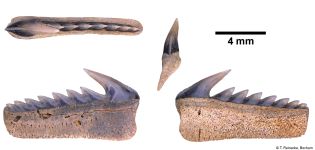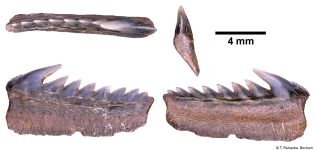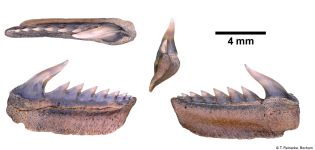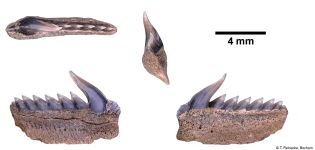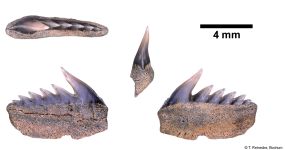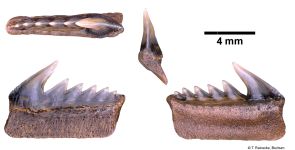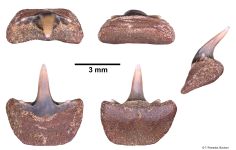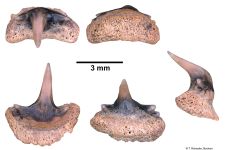Weltonia burnhamensis
Ward, 1979
Classification: Elasmobranchii Hexanchiformes Hexanchidae
Reference of the original description
Additions to the fish fauna of the English Palaeogene. 3. A review of the Hexanchid sharks with a description of four new species. Tertiary Research, 2(3), 111–129
Additions to the fish fauna of the English Palaeogene. 3. A review of the Hexanchid sharks with a description of four new species. Tertiary Research, 2(3), 111–129
Types
Weltonia burnhamensis
Holotype: BMNH(fossil): P.60137; NHMUK: PV P 60137; Paratype: BMNH(fossil): P.60138; BMNH(fossil): P.60139; NHMUK: PV P 60139; NHMUK: PV P 60138; NHMUK: PV P 28890 d;
Weltonia burnhamensis
Holotype: BMNH(fossil): P.60137; NHMUK: PV P 60137; Paratype: BMNH(fossil): P.60138; BMNH(fossil): P.60139; NHMUK: PV P 60139; NHMUK: PV P 60138; NHMUK: PV P 28890 d;
Description:
Citation: Weltonia burnhamensis Ward, 1979: In: Database of fossil elasmobranch teeth www.shark-references.com, World Wide Web electronic publication, Version 01/2026
Please send your images of "Weltonia burnhamensis" to info@shark-references.com
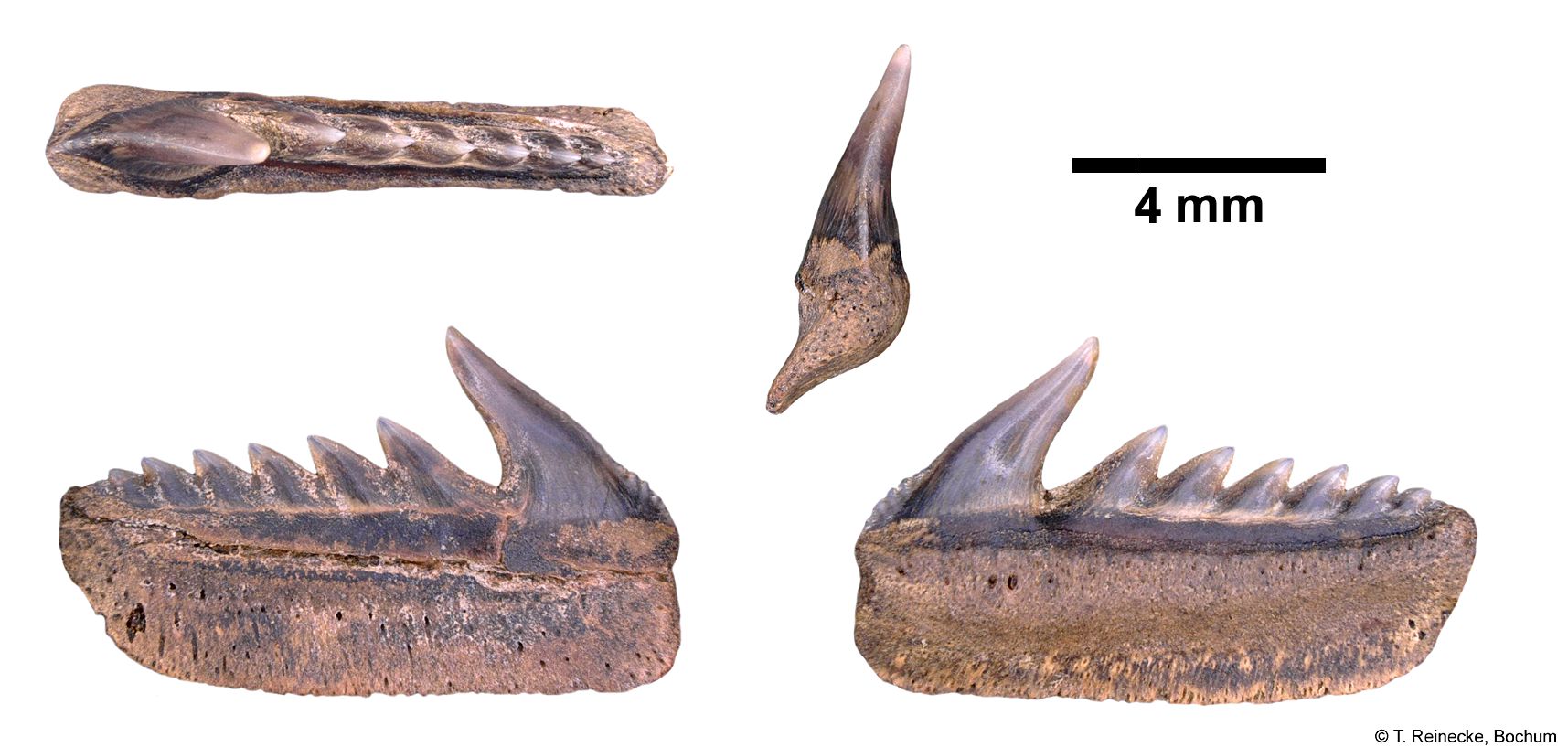
Weltonia burnhamensis Ward, 1979; London Clay Formation, Division D, Sheppey Member, Ypresian, early Eocene; Cliff Reach, Burnham-on-Crouch, UK © T. Reinecke, Bochum

Weltonia burnhamensis Ward, 1979; London Clay Formation, Division D, Sheppey Member, Ypresian, early Eocene; Cliff Reach, Burnham-on-Crouch, UK © T. Reinecke, Bochum
Description
Original diagnosis after Ward (1979) p. 118 (genus Diagnosis) and 119 [2493]: (based on isolated lower antero-lateral teeth only). Antero-lateral teeth characteristic of family. Principal cusp commisurally directed, sigmoid, distinctly larger than and almost separated from first distal cusplet. Labial surface of principal cusp strongly convex, lingual surface flat or slightly convex. Distal cusplets commisurally directed, 4-8 in number. Weltonia having principal cusp approximately 50% longer than the first of the five to eight distal cusplets. Gradient monognathic, heterodonty present.
Original diagnosis after Ward (1979) p. 118 (genus Diagnosis) and 119 [2493]: (based on isolated lower antero-lateral teeth only). Antero-lateral teeth characteristic of family. Principal cusp commisurally directed, sigmoid, distinctly larger than and almost separated from first distal cusplet. Labial surface of principal cusp strongly convex, lingual surface flat or slightly convex. Distal cusplets commisurally directed, 4-8 in number. Weltonia having principal cusp approximately 50% longer than the first of the five to eight distal cusplets. Gradient monognathic, heterodonty present.
Remarks
shark-references Species-ID=7512;
valid after Ward (1979) p. 118 [2493]; Migom et al. (2021) p. 13 [29914];
shark-references Species-ID=7512;
valid after Ward (1979) p. 118 [2493]; Migom et al. (2021) p. 13 [29914];
References

Faszination Haie – Die Welt der fossilen und der lebenden Haie. Der Steinkern, 58, 1–116

Fossile hajtaender fra Trelde Naes. Self-published

The Lower Eocene (Ypresian) Chondrichthyes from Egem, Belgium. Part 1, Orders: Hexanchiformes, Squaliformes, Squatiniformes, Heterodontiformes and Orectolobiformes. Palaeo Ichthyologica, 15, 1–55
A study of the sharks and rays from the Lillebælt Clay (Early–Middle Eocene) of Denmark, and their palaeoecology. Bulletin of the Geological Society of Denmark, 62, 39–88
DOI: 10.37570/bgsd-2014-62-04

London Clay Fossils of Kent and Essex. Rochester, Kent, Medway Fossil and Mineral Society, 228 p, ISBN: 978–0–9538243–1–1

London Clay Fossils of the Isle of Sheppey. Medway Lapidary and Mineral Society, ISBN 0-9538243-0-6, 100pp.

Fossil sharks, rays and chimaeroids of the English Tertiary period. Gosport Museum, 1–47, 10 fig., 3 tabl., 16 pl.

The distribution of sharks, rays and chimaeroids in the English Palaeogene. Tertiary Research, 3(1), 13–19

Additions to the fish fauna of the English Palaeogene. 3. A review of the Hexanchid sharks with a description of four new species. Tertiary Research, 2(3), 111–129

Faszination Haie – Die Welt der fossilen und der lebenden Haie. Der Steinkern, 58, 1–116

Fossile hajtaender fra Trelde Naes. Self-published

The Lower Eocene (Ypresian) Chondrichthyes from Egem, Belgium. Part 1, Orders: Hexanchiformes, Squaliformes, Squatiniformes, Heterodontiformes and Orectolobiformes. Palaeo Ichthyologica, 15, 1–55
A study of the sharks and rays from the Lillebælt Clay (Early–Middle Eocene) of Denmark, and their palaeoecology. Bulletin of the Geological Society of Denmark, 62, 39–88
DOI: 10.37570/bgsd-2014-62-04

London Clay Fossils of Kent and Essex. Rochester, Kent, Medway Fossil and Mineral Society, 228 p, ISBN: 978–0–9538243–1–1

London Clay Fossils of the Isle of Sheppey. Medway Lapidary and Mineral Society, ISBN 0-9538243-0-6, 100pp.

Fossil sharks, rays and chimaeroids of the English Tertiary period. Gosport Museum, 1–47, 10 fig., 3 tabl., 16 pl.

The distribution of sharks, rays and chimaeroids in the English Palaeogene. Tertiary Research, 3(1), 13–19

Additions to the fish fauna of the English Palaeogene. 3. A review of the Hexanchid sharks with a description of four new species. Tertiary Research, 2(3), 111–129








